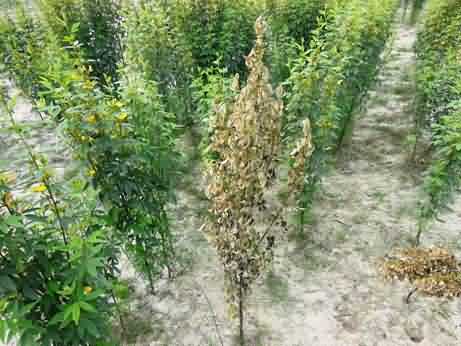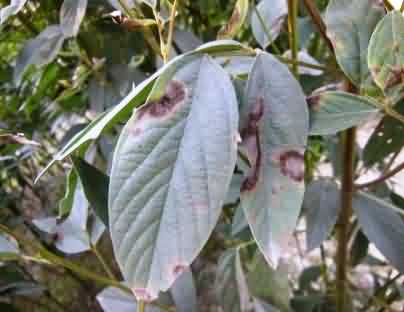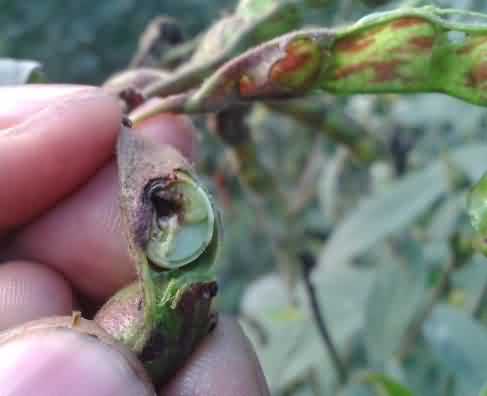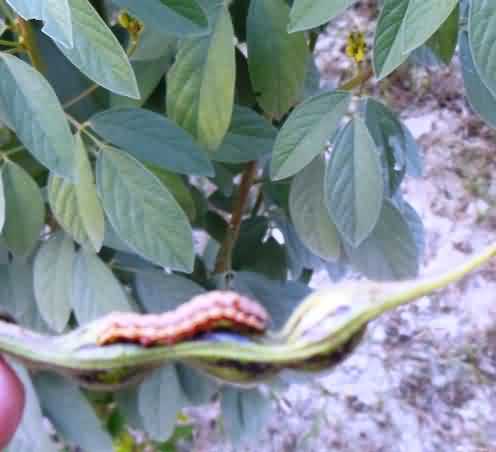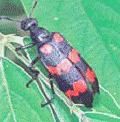अरहर के मुख्य रोगों तथा कीटों का एकीकृत प्रबंधन
Pigeonpea (Cajanus cajan (L.) Millsp.) is one of the most important legume crops of India. It is known as red gram, arhar and tur in the country. It is an important source of proteins (22%) along with carbohydrates, fibre, certain minerals viz., iron, calcium, magnesium, zinc, iodine, potassium and Phosphorous and ‘B’ complex vitamins. Pigeonpea stalks are also a major source of firewood and live stock feed. India is the world’s largest producer and consumer of pulses including pigeonpea.
About 90% of the global pigeonpea area is in India contributing to 93% of the global production. It occupies 4.9 m ha area with 3.1 mt production which accounts for a productivity of 1145 kg/ha; ranking ninth in the world.
Kharif is the main growing season of pigeonpea in India and major pigeonpea growing states are Maharashtra, Uttar Pradesh, Madhya Pradesh, Karnataka, Gujarat, Andhra Pradesh, Tamil Nadu, Bihar and Chhattisgarh. Cultivation of pigeonpea on bunds in low land areas is becoming popular and profitable among the farmers.
Traditional varieties of pigeonpea need about 6 to 9 months to mature, while the improved varieties developed can be harvested in 3-4 months. Both long duration (180 days) and medium duration (130-140 days) genotypes are grown in India under various cropping systems.
This pulse crop is grown mostly as an intercrop between cereals crops and plays a unique role in enriching the soil, by adding 40-90 kilogram nitrogen per hectare over a given season.
It has the ability to resist drought and to add large quantities of biomass to the soil in addition to nitrogen fixation makes it a good choice for rainfed as well irrigated production systems.
The deep root system of the crop helps to recycle plant nutrients from deeper layers, and the acid secretions from its roots increase the availability of phosphorus in the soil. Limitation to the increasing productivity of pigeonpea is also due to abiotic and biotic stresses prevalent across the pulse growing regions.
Among biotic stresses diseases viz., Fusarium wilt, Phytophthora Blight, sterility mosaic and foliar diseases and, insect pests feeding on pods lead to significant yield losses. Management of these stresses can contribute to a yield recovery of 300-350 Kg/ha.
Major diseases of Pigeonpea
1. Fusarium wilt
अरहर की फसल मे फयूसेरियम विल्ट का प्रकोप
It is the most destructive disease of pigeonpea throughout India caused by fungal pathogen i.e., Fusarium udum Butler. The plant mortality upto 50 per cent has been observed with severe infection of wilt.
The main symptoms are wilting of seedlings and adult plants. The wilting starts gradually showing yellowing and drying of leaves following by wilting of whole infected plant. The affected plants can easily be recognized in patches in the field. Wilt appears on the young seedlings but mainly observed during flowering and podding stage.
Disease symptoms resemble plants suffering from drought even with availability of plenty of soil moisture. Brown or dark purple coloured bands are found on the surface of stem which start from base to several feet above ground level.
Drying of plants may be partial or complete. The branches arising from discoloured parts show the wilting symptoms first. The wilting may be partial as the branches on one side will show wilting while on the other side they remain healthy.
The wilt pathogen Fusarium udum is soil borne in nature. The pathogen survives in soil as a saprophyte on dead host roots and other plant part for long time. Under favourable conditions, the spores germinate with a germtube which penetrates the fine rootlets. The fungus may move to larger roots if they got injury.
The affected roots become black and shrivelled. The disease is favoured at a temperature of 17-25 0C. The main infection is through soil only and secondary infection by conidia on above ground parts is rare. The infected plants develop spores which fell down on the soil and functions as inoculum for the next crop.
2. Phytophthora Blight
The causal organism of the disease is Phytophthora drechsleri Tucker f. sp. cajani. Blight causes rapid wilting of plants, desiccation and upward rolling of leaflets followed by withering of petioles and small stems.
Infected plants have brown water soaked circular or irregular lesions on leaves which become necrotic afterward. Affected plants also show brown to dark brown slightly sunken marked lesions on their stem near soil surface and on above ground part of stem.
The lesions enlarge in size and girdle the stems which break at this point. In advanced stages, the stem is commonly swollen into cankerous structures near the lesions. The seedlings die suddenly due to infection.
In severe cases, the whole foliage becomes blighted. White-pink fungal growth appears on the blighted area under congenial weather conditions. The seedlings are highly prone to this infection and dry plants are common during rainy season. The disease is serious when continuous rains occur or there is water logging in the field. Such conditions can create epidemic of the disease, however plants are not affected after 60 days of growth.
The pathogen survives in soil and on infected plant debris. Cloudy weather and drizzling rain with temperature of 25 0C favour infection. Low lying area where water stagnates and close spacing encourage blight build up. Warm and humid weathers after infection result in rapid development of disease.
3. Powdery mildew
Powdery mildew of pigeonpea is caused by Leveillula taurica which is common in some part of India. Disease often found on leaves, flower buds under favourable environmental conditions. White powdery patches are found on both surfaces causing premature defoliation. Severe infection cause yellowing of leaves with crinkling. The fungus is airborne, spreading from one field of pigeonpea to another in the vicinity.
4. Alternaria blight
This disease is caused by fungus Alternaria alternata. It appears in the form of light to dark prominent brown small necrotic spots on the leaves and pods.
Severe infections cause defoliation and destruction of crop. Disease is mostly confined to older leaves but may infect new leaves in post rainy season.
5. Cercospora leaf spot
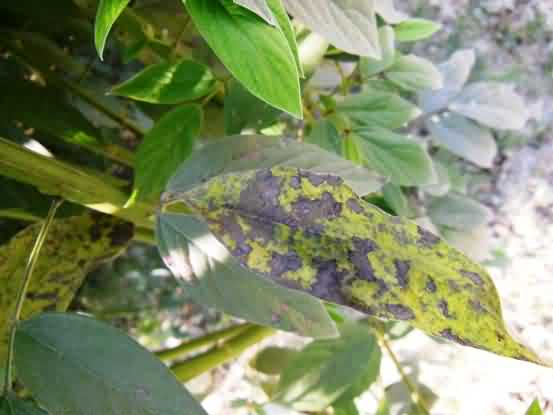 अरहर मेे सरकोस्पैरा पतती धब्बा रोग
अरहर मेे सरकोस्पैरा पतती धब्बा रोग
This leaf spot disease is caused by fungus Cercospora indica. It is present in parts of Uttar Pradesh, Bihar and several places of South India.The symptom first appears as minute circular to irregular brown necrotic spots, one to two mm in diameter, mainly on lower surface of older leaves. Several lesions coalesce causing leaf blight and premature defoliation. Sometime, lesions appear on petiole, young branches and cause their tips to dry and die back. Fluffy mycelial growth or concentric zonations on lesions are also seen.
6. Sterility Mosaic Disease
बाँझपन मोज़ेक रोग
Sterility mosaic is one the most damaging disease of pigeonpea in Indian subcontinent. The disease is caused by pigeonpea sterility mosaic virus (PPSMV). The disease is characterized by malformed, crinkled leaves, mosaic symptoms, reduction in leaf size and ring spots on leaflets are common.
Plants present pale green and bushy appearance without flowers and pods. Sterility of plants can be partial or full. Partially sterile plants produce discoloured and shrivelled seeds. The plants infected with sterility mosaic remain stunted. The leaves show mosaic symptoms and the symptoms may develop on all the leaves of infected plants.
The flowering is partially or completely stopped and a few flowers which develop are sterile. Infection by the pathogen in plants when they are less than 45 days old results in 95-100 % losses, while older plants suffer 26-97 % losses.
The sterility mosaic thrives readily in crops under irrigation or near irrigated fields. Such crops remain at risk of early infection. The disease is transmitted by the eriophid mite Aceria cajani.
The virus and the vector mite both survives on self sown plants during off season and when the crop is sown the virus infection takes place through the vector. The secondary infection takes place from primarily infected plants in the crop by the mite vector.
Integrated Disease Management of Pigeonpea
- Long crop rotations for 3-4 year with non host crop like,tobacco, sorghum, pearl millet, cotton is recommended and has been found very effective for wilt and sterility mosaic disease management.
- Selection of disease-free fields, soil solarization or summer ploughing and wide row interspacing are good agricultural cultural practices advocated for disease management.
- Mixed cropping with sorghum, amendment of soil with oil cakes, appliances of trace elements such as boron, zinc and manganese and heavy dose of green leaf manure crops are remedial measures helps in checking the severity of wilt and blight diseases.
- Cultivation of pigeonpea on ridges with proper drainage system and avoiding the sowing in heavy soil helpful in disease management.
- Soil amendment with Trichoderma @ 1.0 kg + 100 kg FYM at the time of field preparation to reduce the incidence of wilt disease.
- Treat the seeds with hexaconazole + captan @ 2.5g/kg seed or metalaxyl @ 2.0 g per kg of seeds (or) carbendazim or thiram @ 2 g/kg of seed 24 hours before sowing (or) with talc formulation of Trichoderma viride @ 4 g/kg of seed (or) Pseudomonas fluorescens @ 10 g/kg seed for better management of diseases.
- First treat the seeds with biocontrol agents and then with Rhizobium. Fungicides and biocontrol agents are incompatible. There should be an interval of atleast 24 hours after fungicidal treatment for giving the bacterial culture treatment.
- Preventive sprays of mancozeb, wettable sulphur or metalaxyl at 15-20 days interval starting from 15 days after germination reduces the incidences of diseases.
- Cultivation of disease tolerant varieties is the most effective method to manage wilt and other diseases of pigeonpea such as Pusa- 9, NP 15, NP 38, AL 1430, which are resistant or relatively less susceptible.
- Eradication of self sown plants in and around pigeon pea fields is very helpful to manage sterility mosaic.
Major insect pests of pigeonpea
Pigeonpea is the second most important and highly profitable pulse crop cultivated in different states in the country under wide variety of agroclimatic conditions and varied cropping systems of different maturity and, hence it is valuables to many pests.
A variety of insect pests infest pulses and the annual yield loss is estimated to be 20 per cent in pigeonpea. About 250 species of insects belonging to 8 orders and 61 families are reported to attack this crop. The early or vegetative stage pests are not causing economic damage. However, the pests of flowers and pod borers are the major and important pests and causing economic damage.
1. Gram pod borer (Helicoverpa armigera)
चना फली बेधक
It is most damaging insect of pigeonpea. A single female lay up to 2000 small white eggs usually singly eggs are laid on flower buds and young pods. Larval colour is varied- yellow, green, pink, orange, brown, or black with dark and light stripes on either side of body.
Full-grown larvae are 30 to 40 mm long and may have various body color and banding patterns. Young larvae are small and found feeding on tender leaflets. Grown up larvae feed on developing seeds by making an entry hole on pods that is cut with clear round margins.
Half portion of larval body remains outside the pod while feeding is also an important. Pupation occurs in the soil or in plant debris. It is the single most important constraint to pulses.
High level of insecticide resistance, make this species one of the most difficult pest to manage. Adult H. armigera have a wing span of about 40 mm with dull brown forewings. The Helicoverpa spp. destroys buds, flowers and pods.
If flowers and pods are not available, larvae will feed upon foliage. There is no resistant variety for pod borers. Planting date is having influence on the incidence of pod borers.
2. Spotted pod borer (Maruca vitrata)
स्पॉट पॉड बोरर
It is an important insect of foliage and pods of pigeonpea. Eggs are laid in small clusters of 10 to 15 on leaves, buds, and flowers. A full-grown larva measures 15 mm in length, with a pale body lined by rows of conspicuous black spots on its dorsal surface. Adults have distinctive white bands on forewings with a wing span of 20 mm.
M. vitrata becomes a menace in early-season pigeonpea especially in areas. Webbing of tender leaves and flower buds together seen on plants indicate the possibility of Maruca damage.
Upon opening of the webs, dull to yellow-white colour larva with dark spots forming distinct series along the length of the body are seen. Larvae feed from inside a webbed mass of leaves, buds, and pods. This behavior makes Maruca a foliage feeder and pod borer.
3. Pod fly (Melanagromyza obtusa)
It has a narrow host range and only feeds on pigeonpea and closely related species. The small, black fly is about 5 mm in length. Eggs are laid in the wall of an immature pod.
The white maggots feed on the developing seed and reach a length of 3 mm before pupating. External symptoms on pods are not highly obvious. Small holes with whitish window are common when a mature maggot about to pupate is seen inside the pod.
Pod fly damage is also inferred through dissection of pods. Maggots feeding on seeds and puparia are seen in pods infested with pod fly. More than one maggot or pupa could be seen inside a single pod. The tunnelling type of feeding found on a seed is indicative of pod fly damage.
Immature stages (maggots and pupae) may or may not be seen. The exit holes are seen on the pod wall.
Pod fly infested pods do not show external evidence of damage until the fully-grown larvae chew holes in the pod walls. This hole provides an emergence "window" through which the adults exit the pod. Pod fly damaged seeds will not germinate and are unfit for human consumption.
4. Plume moth (Exelastis atomosa)
It is common in pigeonpea and is a major pest in several areas of India. Adult plume moths measure 10mm in length, and have fringed wings that are held perpendicular to the body at rest.
Eggs are laid singly on buds and pods. The full-grown larva is about 15mm long, green, and has a spindle-shaped body covered with short spines. Plume moth caterpillars are more rampant during the post rainy season than during the rainy season. Larvae feed on buds, flowers and pods, resulting in reduced yields.
5. Blister beetle (Mylabris spp.)
ब्लिस्टर बीटल
Blister beetles are widespread in pigeonpea in Asia. Mylabris pustulata adults measure about 25 mm in length and have red and black alternating bands on the elytra. Other species may vary in size but all are brightly colored.
Eggs are usually laid in the soil and the diet of the larvae consists of other soil insects, including major pests. Adult beetles feed on flowers and tender pods, and may have a significant impact on yields, especially of short-duration genotypes.
Adults are black in colour with large yellow spots and a red band across the abdomen. Number of spots varies with species. Adult beetles feed on flowers and tender pods, and may have a significant impact on yields, especially of short-duration genotypes.
6. Blue butterfly (Lamides boeticus)
Larvae are green, oval and flat. Larvae feed on leaves, flower buds and green pods. Larvae are green with brown lateral stripes on the body. They feed on flower buds and green pods.
7. Mealybugs
Mealy bugs are also attaining major pest status causing 10–75 per cent damage in different states of India. They are soft bodied insects covered with white waxy coatings. Crawlers are small and numerous found in aggregation.
Leaves, stems and terminal shoots are largely infected. Ant association and sooty mould infestations are also seen. Different species of mealybugs occur. Phenacoccus solenopsis, Paracoccus marginatus and Coccidohystrix insolita are some of the recently documented species of mealy bugs on pigeonpea.
Integrated Insects Management in Pigeon pea
- Installation of bird perches @ 50/ha for rigorous feeding of insects.
- Use H. armigera pheromone trap @ 12/ha.
- Hand collection and destruction of fully grown larvae. Mechanical collection of grown up larva and blister beetle is effective.
- Practice crop rotation, planting non-leguminous crops every cropping season breaks the life cycle of bean pod borers.
- Spraying Neem seed kernel extract (NSKE) 5 per cent at 50% flowering stage to manage the insect’s populations.
- Spraying HaNPV at (500 larval equivalent per hectare) at 15 days after first spray.
- Spraying of NSKE 5% twice followed by triazophos 0.05% is also effective.
- The recommended action threshold for Helicoverpa to initiate protection operations in pigeonpea when one notices.
- 1 small larva or 3 eggs per plant in short-duration, 3 small larvae or 5 eggs per plant in medium-duration and 5 small larvae or 10 eggs per plant in long-duration.
- Apply Ha NPV 3 x1012 POB/ha in 0.1% teepol for Helicoverpa. Apply chlorpyriphos @ 2.5 l/ha or quinalphos @ 2.0 l/ha or acephate @ 1.0kg/ha alternatively during flowering & pod formation stage. Ensure thorough coverage (900-1000 l/ha). Insecticide / Ha NPV spray should be made when the larvae are upto third instar.
- Two sprays of Spinosad @ 75 g a.i. /ha, first at grain filling stage of pods and second at full grain stage followed by Indoxacarb @ 60 g a.i. /ha. were found best in pod fly suppression,
- Use hydraulic / pneumatic hand compression sprayers (900-1000 l/ha).
- Follow need based application, Avoid cocktail mixtures, Aim the sprayings at early instars. Discourage synthetic pyrethroids and Avoid sublethal dosages for Maruca and other insects.
Authors:
Dr. Ashish Kumar Gupta1, Dr. Wajid Hasan2, Dr. Deepak Singh3
1Senior Scientist (Plant Pathology), IARI RS, Pusa, Samastipur-848 125, Bihar
2Subject Matter Specialist (Plant Protection), KVK, Jehanabad-804 432, Bihar
3Subject Matter Specialist (Plant Protection), KVK, Sitamarhi-843 320, Bihar
1E mail:

